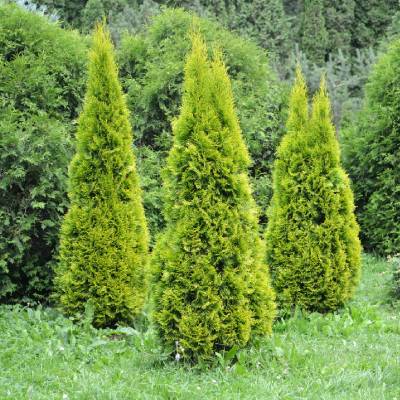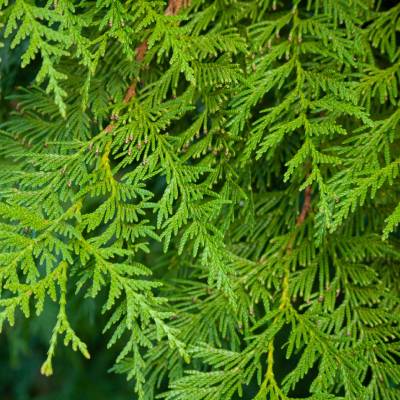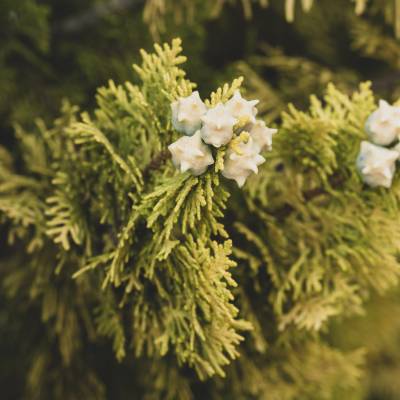Table of Contents
Arborvitae Trees Overview
Origin
Arborvitae trees belong to the genus Thuja and consist of coniferous trees. They are in the Cupressaceae family. There are five total species of arborvitae trees, two of which are native to North America and the other three are native to eastern Asia.
Appearance
Arborvitae trees are evergreen trees that range from 10 feet in height to 200 feet in height depending upon the exact species. They have stringy reddish-brown bark and flat shoots that are only in one place.
The leaves on arborvitae trees are scale-like and range in size from 1-10mm long unless the tree is a seedling in which the leaves are more needle-like. For mature trees that have scale-like leaves, they are in decussate pairs. The pairs are in 4 rows along the branches. The leaves are in flattened fan-shaped groupings with resin glands.
Species of Arborvitae Trees
There are five total species of arborvitae trees that are all native to different areas of the world.
Thuja occidentalis L.

Thuja occidentalis L.
The common name for this type of arborvitae tree is eastern arborvitae or northern whitecedar. It is native to eastern Canada and north-central as well as the northeastern United States. It is very common in residential gardens and yards because this type of arborvitae tree is widely available.
This northern white cedar is a small to medium-sized tree that will grow to a height of almost 50 feet with an almost 3-foot wide trunk diameter. It has red-brown bark and it peels in longitudinal strips.
These trees grow naturally in wet forests and are abundant in coniferous swamps. Because this is a smaller tree, it does best in areas without the competition of larger trees, which can include areas such as cliffs.
Thuja plicata

Thuja plicata
This type of arborvitae tree is commonly known as western redcedar. They are typically native to the western portion of North America from Canada all the way down to Mendocino County in California.
This tree is large to the very large size when fully grown to reach heights of 150 to 230 feet and a trunk diameter of 8 to 23 feet. These trees will sometimes have a crown that reaches the ground and others may only have a crown at the top because light can reach the leaves better.
The trunk on these trees will swell at the base and have shallow roots. Their bark is gray-brown in color and thin. It is also fissured in vertical bands.
This type of arborvitae tree is one of the most widespread in the Pacific Northwest. It is commonly found in areas that are moist and have rainfalls that exceed 30 inches annually.
They are found to be growing naturally from sea level to elevations up to 3,600 feet. It will typically grow in lush forests and mountainsides, but can also grow in forested swamps and streambanks.
Thuja koraiensis

Thuja koraiensis
Commonly known as the Korean arborvitae, this species of arborvitae tree is native to
Korea and the northeastern area of China. It has a small population and is in a protected nature reserve both in Korea and China.
It is a small evergreen shrub or small tree that can grow 3 to 10 meters tall. The foliage is unique in that it is dark green with white wax bands.
Thuja standishii

Thuja standishii
This type of arborvitae tree is native to Japan and grows on the islands of Shikoko and Honshū. It is a medium tree that can grow to heights of 25-35 meters tall with a trunk diameter of 1 meter.
It has scale-like leaves that are green with white stomatal bands. It is grown in forestry plantations in Japan due to its waterproof, durable, and beautifully scented wood.
Thuja sutchuenensis
Also known as the Sichuan thuju, this type of arborvitae tree is native to China where it is considered endangered. This tree is considered a small to medium tree that can reach up to 20 meters in height.
It has leaves that are in large sprays with a green color above and white stomatal bands below. At one time it was considered extremely valuable because of the scented wood and many people believed that it was extinct. However, it was rediscovered and is now in an area where the species is protected.
Caring for Arborvitae Trees
When to Plant Arborvitae Trees
It is best to plant arborvitae trees either in the spring after the last frost or in the fall before the first frost and the ground hardens. Arborvitae trees can be planted and grown in USDA zones 3 to 8.
By avoiding the last or first frosts of the year, you ensure that your tree will have enough time to become established before the harsh winter season hits even though the arborvitae trees are evergreen so they will keep their beautiful green foliage all year long.
How to Plant Arborvitae Trees
When you are ready to plant your arborvitae tree it is important to have a plan in place when you begin the planting process. Be sure to select a location that provides adequate sunlight. Because these trees can grow extremely tall, you want to ensure that they are 15 to 20 feet away from buildings or your house due to their size when fully grown.
If your root ball is wrapped in anything, you can unwrap it and spray it off with the hose. You will want to dig a hole that is 2 to 3 times deeper and wider than the root ball. Once you place the root ball into the hole you can fill it halfway back up with soil and then generously moisten the soil. Once you complete filling the hole, you will want the root ball to end up approximately level with the ground.
At the end of the planting process, you will tamp down the soil and provide a generous amount of water on top. If you want the soil to retain moisture well, you can add a couple of inches of mulch to the top of the soil.
Sunlight
Arborvitae trees do best with plenty of direct sunlight. Ideally, 6 hours or more of direct sunlight will help your arborvitae thrive, but they can also do well in partial shade with 4-5 hours of midday sunshine.
The more sunshine the better for arborvitae trees, but they are hardy enough to do well in varying amounts of sunlight. It is best to give them ideal sunshine when they are young as they need to establish and require more attention and care. Once the tree is established, it can tolerate more shade without any harm being done.
Hydration
Arborvitae trees do best in soil that is well moistened. The climate as well as the age of the tree also plays a role in how much hydration the tree actually needs. A rule of thumb with arborvitae trees is 10 gallons of water per inch of the tree’s diameter. This can equate to a lot of water-dependent upon the size of the tree.
Many arborvitae trees grow in areas with plenty of moisture and rainfall throughout the year. However, if you are trying to grow an arborvitae tree in an area of drought, you will need to provide plenty of water to keep the soil moistened.
It may take some trial and error to figure out how often you need to water your arborvitae, but you can check the moisture levels in the soil to determine if you need to water more or less frequently. Ideally, the soil will stay moist 1 foot deep.
If you are not watering your arborvitae tree enough, you may notice yellowing or browning of the leaves, as well as the needles, falling off. However, overwatering can cause discoloration as well along with root rot and fungus.
Fertilization
Many arborvitae trees do not require fertilization, which makes them easy to care for. However, if they are competing with other plants and trees in the same area then they may not be able to absorb the proper amount of nutrients from the soil. In these cases, you may need to supplement fertilizer for your arborvitae.
A complete fertilizer that is slow-release and granular is perfect for arborvitae. If you can find one that is at least 50% nitrogen that is ideal as the fertilizer will have an adequate amount of nitrogen that will slowly release into the soil, which reduces the chance of the roots burning.
Soil
Arborvitae trees are fairly hardy and can adapt to a range of soil types, but they prefer loams. Once the tree is established they are better able to handle different types of soil including those that are very dry.
The soil pH should be slightly acidic to moderately alkaline falling in the 6.5 to 8.0 pH. If you are unsure of your soil pH, you can always do a test to check the pH levels and then adjust them as needed by adding limestone or sulfur.
Diseases of Arborvitae
As with many plants, trees, and shrubs, arborvitae trees are also prone to certain diseases. Many of them can be treated or controlled if caught early so it is important to be aware of the potential diseases that arborvitae trees can be infected with so you can try to resolve the issue as early as possible to preserve the health of the tree.
Kabatina Twig Blight
Kabatina Twig Blight will affect young branches that are around one year old and will cause them to turn brown or ash gray and then die. They can potentially infect older branches as well if it is not caught quickly enough. It is noticeable by small black pimple-like fungus that will begin on branches that are still alive. It is treated by removing all infected branches and leaves and then treating the tree with a fungicide.
Pests
Scales and spider mites can be a problem for arborvitae trees. Scales are noticeable because they look exactly like scales on the tree and have a waxy coating that can be easily seen.
Spider mites are very small and almost impossible to see with the naked eye, but if you notice webbing around the branches or leaves of the tree there is a good chance you have spider mites. Treatment for these pests includes neem oil, insecticidal soap, and horticulture oil. These three products can typically be purchased at any garden center.
Bagworm is another somewhat common pest problem with arborvitae trees. A bagworm is a moth whose caterpillar feeds on a tree. If not caught quickly, they will destroy the tree’s leaves and twigs. The symptoms of bagworm include the tree beginning to lose foliage, but also the bags of silk hanging from the leaves. The silk bags are typically around 2 inches in length. If not caught early enough, bagworm can cause the plant to lose a large amount of foliage as well as stunt the growth of the tree if it is not entirely mature.
Root Rot
If soil conditions are not great for arborvitae trees it can cause root rot. They do require good drainage so if their soil is not getting good drainage and they have been overwatered then the moist conditions can cause root rot.
The symptoms of root rot that you will see include discoloration of foliage and then eventually the tree will die. Root rot can be prevented by ensuring adequate drainage and the proper amount of hydration for the tree. This is especially important if you live in a climate with warmer weather as moisture and warmth are the ideal conditions for root rot to develop.
Are Arborvitae Trees Poisonous?
Arborvitae trees and plants are not known to be toxic to humans or animals. However, in people that are sensitive-skinned, long-term exposure to the foliage can occasionally cause skin irritation in some people.
Children should be treated the same way as adults with arborvitae trees. It is not typically known as a tree that is toxic, but it has the potential to cause some skin irritation in some children if they have sensitive skin.
Thujas are not known to be poisonous to dogs and are not listed on the ASPCA’s toxicity list, but if ingested in large amounts it can cause digestive upset in dogs so it is best to have animals avoid them in general if possible.
Arborvitae Trees for Medicinal Purposes
The leaves and leaf oil of Thuja trees have been used for medicinal purposes. These include being used for respiratory tract infections, bacterial skin infections, and cold sores.
It has been used to reduce phlegm in the form of an expectorant, boost the immune system as an immunostimulant, and increase urine flow as a diuretic.
When using Thuja leaves or leaf oil it can be applied directly to the skin for purposes such as joint pain, muscle pain, and osteoarthritis. For other ailments, it can be ingested orally to be used as treatment.
It is important to note that Thuja should only be used under the care of a professional due to the plant contain thujone, which is a chemical that can be toxic in large doses.
Recent Articles

















